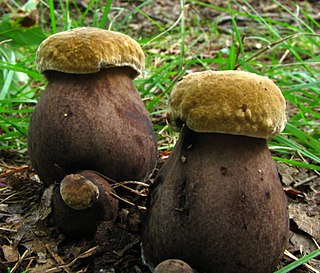
Tylopilus is a genus of over 100 species of mycorrhizal bolete fungi separated from Boletus. Its best known member is the bitter bolete, the only species found in Europe. More species are found in North America, such as the edible species T. alboater. Australia is another continent where many species are found. All members of the genus form mycorrhizal relationships with trees. Members of the genus are distinguished by their pinkish pore surfaces.

Tylopilus felleus, commonly known as the bitter bolete or the bitter tylopilus, is a fungus of the bolete family. Its distribution includes east Asia, Europe and eastern North America, extending south into Mexico and Central America. A mycorrhizal species, it grows in deciduous and coniferous woodland, often fruiting under beech and oak. Its fruit bodies have convex to flat caps that are some shade of brown, buff or tan and typically measure up to 15 cm (6 in) in diameter. The pore surface is initially white before turning pinkish with age. Like most boletes it lacks a ring and it may be distinguished from Boletus edulis and other similar species by its unusual pink pores and the prominent dark-brown net-like pattern on its stalk.

Hypomyces chrysospermus, the bolete eater, is a parasitic ascomycete fungus that grows on bolete mushrooms, turning the afflicted host a whitish, golden yellow, or tan color. It is found in Eurasia and North America, as well as southwest Western Australia.

Tylopilus plumbeoviolaceus, commonly known as the violet-grey bolete, is a fungus of the bolete family. First described in 1936, the mushroom has a disjunct distribution, and is distributed in eastern North America and Korea. The fruit bodies of the fungus are violet when young, but fade into a chocolate brown color when mature. They are solid and relatively large—cap diameter up to 15 cm (5.9 in), with a white pore surface that later turns pink, and a white mycelium at the base of the stem. The mushroom is inedible. A number of natural products have been identified from the fruit bodies, including unique chemical derivatives of ergosterol, a fungal sterol.

Tylopilus alboater, called the black velvet bolete, by some, is a bolete fungus in the family Boletaceae. The species is found in North America east of the Rocky Mountains, and in eastern Asia, including China, Japan, Taiwan, and Thailand. A mycorrhizal species, it grows solitarily, scattered, or in groups on the ground usually under deciduous trees, particularly oak, although it has been recorded from deciduous, coniferous, and mixed forests.

Tylopilus atronicotianus, commonly known as the false black velvet bolete, is a bolete fungus in the family Boletaceae. First described scientifically in 1998, it is known only from the eastern United States.

Tylopilus badiceps is a bolete fungus in the family Boletaceae native to North America. It was described in 1900 as Boletus badiceps by Charles Horton Peck, and transferred to the genus Tylopilus in 1971 by Alexander H. Smith and Harry Delbert Thiers. It is a good edible mushroom.
Tylopilus atratus is a fungus of the genus Tylopilus native to North America. It was described scientifically by Ernst Both in 1998.

Tylopilus rhoadsiae, commonly known as the pale bitter bolete, is a bolete fungus in the family Boletaceae native to the eastern United States.

Harrya chromapes, commonly known as the yellowfoot bolete or the chrome-footed bolete, is a species of bolete fungus in the family Boletaceae. The bolete is found in eastern North America, Costa Rica, and eastern Asia, where it grows on the ground, in a mycorrhizal association with deciduous and coniferous trees. Fruit bodies have smooth, rose-pink caps that are initially convex before flattening out. The pores on the cap undersurface are white, aging to a pale pink as the spores mature. The thick stipe has fine pink or reddish dots (scabers), and is white to pinkish but with a bright yellow base. The mushrooms are edible but are popular with insects, and so they are often infested with maggots.
Tylopilus brunneirubens is a bolete fungus of the genus Tylopilus. It was originally described in 1972 by E.J.H. Corner, and transferred to Tylopilus by Roy Watling in 1994. The fungus has been recorded from Malaysia and Zambia, and Singapore.
Tylopilus subvinaceipallidus is a bolete fungus found in New South Wales, Australia.
Tylopilus cyanogranulifer is a bolete fungus found in Queensland, Australia, where it grows in Eucalyptus rain forest.
Tylopilus cyanescens is a bolete fungus found in New South Wales, Australia, where it grows on sandy soils in eucalypt forest. It was described as new to science in 1999 by mycologists Roy Watling and Tai-Hui Li.
Tylopilus hongoi is a bolete fungus in the family Boletaceae found in Japan, where it grows in coniferous forest under fir, spruce, and birch. It is named after mycologist Tsuguo Hongo.
Tylopilus piniphilus is a bolete fungus in the family Boletaceae found in Yunnan, China, where it grows under the conifer species Pinus yunnanensis and P. densata.
Tylopilus chromoreticulatus is a bolete fungus in the family Boletaceae found in Yunnan, China, where it grows under Pinus densata. It was described as new to science in 1993.
Tylopilus nebulosus is a species of bolete fungus in the family Boletaceae found in eastern North America. It was originally described by Charles Horton Peck in 1898 as a species of Boletus, from collections made in Ray Brook, New York. Carl B. Wolfe transferred it to the genus Tylopilus in 1980.

Sutorius eximius, commonly known as the lilac-brown bolete, is a species of fungus in the family Boletaceae. This bolete produces fruit bodies that are dark purple to chocolate brown in color with a smooth cap, a finely scaly stipe, and a reddish-brown spore print. The tiny pores on the cap underside are chocolate to violet brown. It is widely distributed, having been recorded on North America, South America, and Asia, where it grows in a mycorrhizal relationship with both coniferous and deciduous trees.









